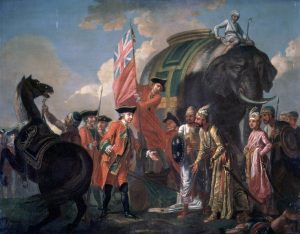Pax Britannica – The Zenith of the British Empire
In the case of Britain’s exports, again she looked more closely to the empire as her main outlet, since foreign markets were being lost either by her being shut out or because she failed to meet foreign competition. By the 1930s the empire was becoming the vital outlet for her industrial goods. “India was the main buyer, followed by Australia although South Africa made a temporary surge in the 1930s. The main foreign buyer was the United States. The closer empire tie for British exports was not, however, reciprocated by the individual colonies.”24 Canada, for example, was more dependent upon the United States than upon Britain for her manufactures. Ceylon together with Australia in the twentieth century obtained more of their imports from sources other than Britain. Moreover, some of the West Indies islands were also choosing American suppliers over British. During the twentieth century as it progressed more and more well established economies kept cutting down Britain’s share of their imports, while there was generally some increase in the empire share as well as in the foreign share. Although there was in most cases a slight British recovery just after 1925, by the mid 1930s the decline set in again. “Even in the dependent empire there was a growing swing away from British manufacturers: Malaya, for example, looking to foreign and empire sources, Ceylon to empire sources and Hong Kong to foreign sources. By contrast West Africa still looked to Britain.”25
It could be said that Britain was relying more and more on empire outlets, whereas the Empire on the other hand was reducing its dependence upon British manufactures. For example, among exports of small value such as beer, soap, books, luxury foods, Britain continued to find empire countries the major buyers. “Australian woman loved to parade in hats from London while eating English chocolates and sipping English tea. Among exports of high value the empire was becoming an essential outlet. Whereas one century previously textiles went out three pieces to foreign countries and to the empire, in 1930 the destinations were pegged almost evenly.”26 There was a growing sense of economic independence, plans for industrialisation and search for diversified trade among the more developed economies (of the dominions). British manufacturers had little reason to have ling-term faith in those empire outlets. Britain could not expect to maintain her share in those countries.
However, Britain was still able to wield authority as a financial centre of the world in comparison with its decline as a trading power. Invisible earnings had always kept British accounts balance. Those earnings were achieving through being a world banker, shipper and insurer, and particularly through dividends from overseas investments. The significance of the income from overseas investment is shown by its increase as a part of the national income, from 4% in 1880 to 10% by 1914. The yearly income from these investments between 1870 and 1914 averaged out at £110 million; obviously it was higher at the later date (1913, £210 million on a total investment of over £3,700 million).



